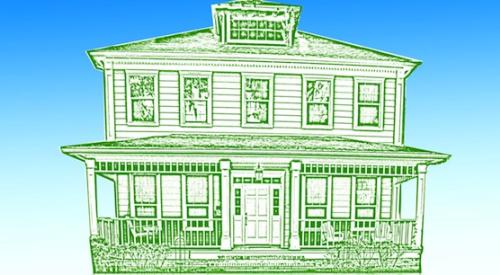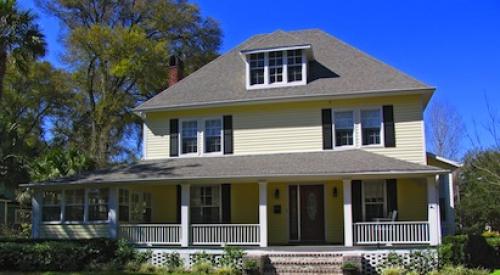 |
Instead, the industry is reminiscent of the end of the Gold Rush era, with tumble weeds blowing across empty lots, for-sale signs dotting lawns and fortune seekers leaving in droves with their pockets turned inside out.
Just as quickly as the Gold Rush came and went, it seems the escalating real-estate market has done the same. Some blame speculators. Some blame builders. Regardless of who was out to make a quick buck, the reality is that housing sales are down 17 percent nationwide from 2005 to year-end 2006 after record double-digit growth in many markets for multiple years, the National Association of Realtors reports.
Housing starts are also down. An estimated 1,800,700 housing units started in 2006, 12.9 percent below the 2005 figure of 2,068,300, according to a report the U.S. Department of Commerce released in January.
Inventory also is up in many markets across the country, and prices are skidding downward as speculators dump their investments on the market and builders try to unload what they can. Apparently, the adage "If you build it, they will come" can only ring true if you don't overbuild and "they" think the market is right.
Housing truly became a commodity in America, and it's with mixed feelings that builders want to fault speculators for that. Given that speculators created a false sense of demand for housing, it was the builders who kept right on building. But that is what they do best, says Jonathan Miller, president-CEO of Miller Samuels Real Estate Appraisers & Consultants in New York. It's like an addiction.
"Builders build. I don't know that there is a natural stop mechanism built in. That is what they are in business to do. During all of this frenzy, I don't know a lot of attention was paid to what the competition was doing. A rational person looking at the Miami skyline would say, 'How can they sell all of these?'" But the buyers kept coming, even if a high percentage of them were speculative investors. In Miami, 15 percent of buyers were speculative investors, according to loan performance data that John Burns of RealEstateConsulting.com gathered.
But we can't blame the builder for this activity, even though everyone knew we had an investor issue. Just how big of an investor activity issue it was nationwide no one really seemed to know until that bubble burst, experts say. And the speculators are trying to dump properties — taking a hit where they were hoping to make dramatic increases.
It basically started when speculative flippers — gobbling up two, three or 10 homes each in various markets — created an illusion that there were more buyers out there than there really were. Consider that every year from 1973 to 2003 the number of home sales averaged to about 4.9 sales for every 100 households. By that calculation, there should have been 5.7 million real-estate sales transactions in 2005. But there were far more: 48 percent more transactions in 2005 — about 8.5 million, according to Census Bureau numbers compiled by John Burns Real Estate Consulting. The NAR says that 28 percent of those transactions came from speculative investors. And those speculators are sitting tight on their money for now.
Incentives 'R UsMary Wozny of Ontario, Canada has purchased multiple units in Michigan, Las Vegas, Florida, West Virginia and Colorado in the last three years. "We've made excellent money in Detroit," says Wozny. "If you can make money in one of the most depressed markets in the country, it shows the opportunities that were out there."
Wozny, who operates Millionaireriches.com and gives hotel-based seminars to other investors, isn't as bullish on the market as she was just a couple of years ago, but she says there are still great opportunities out there. Why? Because the builders are offering great incentives just to move inventory and pay some bills.
"Investors can meet a lot of builders' needs," she says, primarily giving them a little bit of cash in their pocket to hold them until other units are sold. "But the investor has to get a great deal — better than what you're offering the general market." For one ski condo she purchased, she was able to get the builder to upgrade cabinetry, lay granite floors instead of carpeting, finish the basement and add a screened porch as shelter from the mosquitoes — and she didn't pay any upgrade charges.
Investors are looking for price appreciation, and whether they get that in incentives or as an increase in home value, it doesn't matter.
"Builders need to continue to do incentives as long as the inventory is there," says David Seiders, the chief economist for the National Association of Home Builders. "I don't want builders to kick it back into gear with more inventory."
Orlando, Fla., condo developer Steve Kodsi, president of Historic Creations Design Development Group, took some of his best units off the market to sell in second quarter 2007 or later so that he is not competing with speculators dumping their inventory onto the market now.
"Developers do not want their residences for sale to compete with investors who are cutting the prices of their units just so they can move them," he says. He adds that he has noticed investor activity slow down.
In one building he has with 173 units, he had about 12 speculators who had bought one or two units each (for a total of about 20 units) before the downtown condo building even broke ground. Most of these investors, he says, were young professionals who sold their units to seniors about two to six months after the building was completed.
"They made about 200 percent on their investment with returns at $100,000 to $215,000," he says. On his current building, the Star Tower, which will be completed this summer, he began taking deposits in second quarter 2005. Just a handful of months away from finishing, he says only about six speculators so far have purchased units.
Some developers are requiring speculators to hold on to their unit for a certain period of time before they can resell it, he says. For Kodsi's company, he is letting the speculators assign their units once the building is painted. "But part of the agreement is that they have to use our real estate company," says Kodsi — a good way to make money back and have a vested interest in seeing the unit seel."
It has taken another developer, MCZ Development, about two years to burn off most of its inventory, says president Michael Lerner, who has offered incentives to buyers. "It's important you don't take that buyer for granted. You need to give them the most bang for the buck."
MCZ Development builds in several markets across the country. "We are in all of the currently overbuilt markets," Lerner says. They are in Washington, D.C.; Boston; Kansas City area; Phoenix; Miami; Orlando; Fort Lauderdale; and others. "The markets that were good two years ago are the markets that got overbuilt, and they got overbuilt because there was demand. Now there is over supply."
Lerner says it was easier to identify the speculators in some of those markets. "There were more speculators in markets like Miami because it has an international draw, but it was a little easier to identify them in Chicago." He says he believes "good-weather" markets and retirement spots will recover more quickly than others, in part because they also will continue to attract foreign investors.
Beyond AmericaAlthough foreign investment in U.S. real-estate is down slightly, there are still significant monies flowing in from abroad, according to the Association of Foreign Investors in Real Estate. Its 2006 Annual Foreign Investment Survey, released in January 2007, revealed that foreign investors have $185 billion invested in U.S. real-estate, of $600 billion in real-estate globally. Less than half of that goes to new home construction in the U.S.
Homes in vacation locales are popular with foreign investors, according to AFIRE. British citizens Joseph Woodhead and his wife, Sarah, both in their early thirties, wanted to invest in a U.S. ski property and came across one near the Big Sky Slopes in Montana, about 45 minutes from the entrance to Yellowstone National Park. The market values in Big Sky increased 40 percent from 2004 to 2005, so in May 2005 for $1.92 million they purchased a 4,000-square-foot, two-story home — the first one to sell at the Clubs at Spanish Peaks golf community. They took a two-week vacation to their home and flipped it for a 60 percent profit one year later when it sold for $2.75 million. Their cousin purchased a lot in the same community for $900,000 and less than a year later put it on the market for $1.6 million.
The Homes that Never FlippedSpeculators across the nation drove up lot prices and home prices in 2006, say experts. And not only did this sometimes screw the locals out of their own market, but it also kept the speculators from being able to purchase properties they put down payments on, let alone purchase other units.
In many cases, speculators were hoping to flip a property quickly — before the date they had to close on the unit. But higher prices meant they weren't finding buyers and that they were also digging a larger debt hole for themselves.
"Some of them now can't afford to buy the house because they bought it with creative financing — nothing down or interest-only payments, because they were hoping to flip it for a profit," says Monica Caruso, a spokeswoman for the Southern Nevada Home Builders Association, which covers Las Vegas, of speculators nationwide. "Now in this market and in other markets they are sitting on properties they can't afford," she says.
From late 2003 to the first part of 2005, speculators drove up Las Vegas new-home prices by 40 percent to 50 percent. And in some of the communities close to 50 percent of the sales went to speculators, says Dennis Smith, president of Home Builders Research in Las Vegas.
Nevada has the second highest rate of foreclosure than any other state, reports the SNHBA, "and that has to do with speculators who bought and never intended on living in it," says Caruso. She says that speculators' spending sprees were not limited to new-home construction. "I personally know people who had strangers banging on their doors with cash in hand, begging to buy their homes even though their home was not for sale. Talk about being obnoxious."
New DirectionWhen the speculators stopped coming to Las Vegas in droves, where did they go? To Phoenix, says Smith. "They went to Phoenix and then the same thing happened there four or five months later," he said. But the Las Vegas market is correcting itself. "Builders put incentives on the existing inventory," says Smith. "The incentives work, and we are in pretty good shape. There are 23,000 listings that are active in the market now [as of late January]; that's down from 29,000, but is still double from the normal." Building permits in Vegas are also down 25 percent from 2005 to yearend 2006, he added.
The largest reduction in new home production has been concentrated in a few states such as Arizona, California, Nevada and Florida. In fact, nine of the Top 10 states that had the most speculative activity have seen some of the biggest declines in new inventory. Phoenix and Fort Lauderdale, Fla. top the list with 17.1 percent, and 17 percent of mortgage seekers who said they were speculators. (Some others may have been as well, but chose not to check the appropriate box in their loan application.) Sacramento, Calif., Las Vegas and Miami round out the top five with somewhere between 16.4 percent and 15.3 percent. (See Top 30 Markets in 2005 with the Most Speculative Activity on page 47.)
For the most part, speculative flippers are out of the market because prices have slipped, and they do not want to buy more units when they can't sell the ones they already have. "There is no question the speculators have retreated," says Seiders. "Prices have started to weaken dramatically in many areas."
Before the market improves, spending on housing will decrease through the first half of 2007 and, on average, prices for homes will also decline in the same time period, according to a January 2007 report from the U.S. Congressional Budget Office. Yet still, economists there are relatively optimistic about the immediate future of the housing market.
Lawrence Yun of the National Association of Realtors agrees. He says the number of new-home sales will more than likely bottom out in the second quarter of 2007. "The lower sales are not due to lack of interest in new-home purchases but from home builders cutting back single-family home construction by about 30 percent on a year-over-year basis at the end of 2007," he says.
As of November, there were still 3.82 million homes on the market compared with about 2.2 million just two years earlier when the market was considered very tight.
However, the agency expects both sales and home prices to edge up in the second half of the year, and it projects that residential construction will pick up by then as well and the investors will probably come back not long there after. The lingering question is, when they do come back, what will you do?
| Phoenix-Mesa, Ariz. | 17.1% |
| Fort Lauderdale, Fla. | 17.0% |
| Sacramento, Calif. | 16.4% |
| Las Vegas | 16.0% |
| Miami | 15.3% |
| West Palm Beach, Fla. | 14.9% |
| Tampa, Fla. | 13.6% |
| Orlando, Fla. | 13.4% |
| San Diego | 13.3% |
| Austin-San Marcos, TX | 13.1% |
| Riverside-San Bernadino, Calif. | 12.8% |
| Portland, Ore., Vancouver, Wash. | 12.2% |
| Baltimore | 12.1% |
| Los Angeles – Long Beach | 11.4% |
| Philadelphia | 10.3% |
| Washington, DC-MD-VA-WV | 9.8% |
| Orange County, Calif. | 9.8% |
| Denver | 9.0% |
| Seattle-Bellevue-Everett | 8.8% |
| Atlanta | 7.6% |
| Dallas | 7.4% |
| Houston | 7.3% |
| Charlotte, N.C. | 7.2% |
| Chicago | 6.9% |
| Minneapolis | 6.8% |
| Boston, MA-NH | 6.7% |
| Detroit | 6.0% |
| St. Louis | 6.0% |
| Nassau-Suffolk-NY | 4.9% |
| New York | 4.7% |
| Source: LoanPerformance, realestateconsulting.com | |
| State | 2003 | 2004 | 2005 | 2005 III | 2005 IV | 2006 I | 2006 II r | 2006 III p | % Chng. |
| (Seasonally Adjusted Annual Rate, 000s) | |||||||||
| United States | 6,175 | 6,779 | 7,075 | 7,180 | 6,943 | 6,790 | 6,687 | 6,270 | -12.7% |
| Northeast | 1,019 | 1,019 | 1,170 | 1,200 | 1,110 | 1,117 | 1,147 | 1,050 | -12.5% |
| Midwest | 1,468 | 1,468 | 1,587 | 1,607 | 1,567 | 1,560 | 1,537 | 1,417 | -11.8% |
| South | 2,283 | 2,283 | 2,703 | 2,733 | 2,720 | 2,703 | 2,600 | 2,520 | -7.8% |
| West | 1,405 | 1,405 | 1,615 | 1,640 | 1,553 | 1,413 | 1,407 | 1,287 | -21.5% |
| ALABAMA | 93.7 | 112.0 | 128.0 | 127.6 | 136.0 | 133.0 | 125.0 | 121.7 | -4.6% |
| ALASKA | 18.4 | 23.0 | 25.6 | 26.0 | 24.4 | 29.0 | 32.7 | 24.9 | -4.2% |
| ARIZONA | 149.6 | 186.8 | 199.0 | 204.4 | 188.8 | 160.8 | 144.2 | 130.8 | -36.0% |
| ARKANSAS | 53.8 | 60.9 | 75.3 | 79.6 | 83.2 | 78.3 | 81.6 | 83.0 | 4.3% |
| CALIFORNIA | 577.6 | 610.1 | 599.6 | 612.4 | 553.2 | 494.7 | 460.5 | 437.5 | -28.6% |
| COLORADO | 112.4 | 126.0 | 130.4 | 132.0 | 130.8 | 125.8 | 130.9 | 120.7 | -8.6% |
| CONNECTICUT | 65.3 | 75.1 | 80.4 | 82.5 | 77.2 | 81.0 | 76.9 | 69.2 | -16.1% |
| DELAWARE | 15.8 | 18.9 | 19.3 | 20.8 | 18.8 | 18.0 | 18.7 | 18.7 | -10.1% |
| District of Columbia | 12.1 | 13.4 | 12.1 | 12.0 | 10.8 | 10.9 | 10.8 | 10.2 | -15.0% |
| FLORIDA | 476.1 | 526.5 | 546.1 | 558.0 | 498.8 | 465.1 | 418.7 | 367.3 | -34.2% |
| GEORGIA | 174.0 | 215.8 | 242.1 | 247.6 | 249.6 | 245.4 | 252.4 | 253.7 | 2.5% |
| HAWAII | 34.4 | 35.5 | 36.8 | 37.6 | 32.4 | 40.3 | 31.8 | 27.9 | -25.8% |
| IDAHO | 27.6 | 32.0 | N/A | 38.4 | N/A | 45.2 | 38.2 | 34.6 | -9.9% |
| ILLINOIS | 275.1 | 307.5 | 315.3 | 322.0 | 318.8 | 307.2 | 299.1 | 284.6 | -11.6% |
| INDIANA | 120.4 | 130.5 | 138.3 | 143.6 | 138.4 | 148.0 | 143.4 | 142.2 | -1.0% |
| IOWA | 62.4 | 71.1 | 75.0 | 76.0 | 76.4 | 77.4 | 77.2 | 72.5 | -4.6% |
| KANSAS | 65.3 | 73.4 | 77.9 | 78.8 | 79.2 | 78.7 | 75.4 | 75.2 | -4.6% |
| KENTUCKY | 81.1 | 89.3 | 96.2 | 96.8 | 100.0 | 95.6 | 95.3 | 94.0 | -2.9% |
| LOUISIANA | 76.2 | 79.6 | 87.2 | 86.8 | 97.6 | 98.8 | 87.3 | 90.7 | 4.5% |
| MAINE | 30.7 | 33.6 | 33.3 | 34.0 | 30.8 | 36.4 | 34.1 | 26.7 | -21.5% |
| MARYLAND | 120.8 | 140.6 | 135.5 | 136.4 | 128.8 | 126.3 | 116.2 | 110.0 | -19.4% |
| MASSACHUSETTS | 118.3 | 141.7 | 148.6 | 152.4 | 146.4 | 140.7 | 128.8 | 121.9 | -20.0% |
| MICHIGAN | 207.4 | 213.4 | 208.1 | 212.8 | 190.8 | 195.7 | 183.1 | 176.2 | -17.2% |
| MINNESOTA | 126.7 | 137.4 | 134.9 | 138.0 | 130.4 | 141.8 | 111.3 | 113.3 | -17.9% |
| MISSISSIPPI | 51.5 | 58.1 | 61.4 | 54.8 | 64.4 | 70.2 | 63.7 | 57.0 | 4.0% |
| MISSOURI | 131.1 | 141.8 | 143.2 | 143.2 | 142.4 | 133.7 | 144.0 | 132.9 | -7.2% |
| MONTANA | 23.2 | 24.2 | 25.7 | 26.4 | 24.4 | 26.8 | 28.2 | 28.1 | 6.4% |
| NEBRASKA | 38.0 | 39.8 | 41.2 | 42.0 | 39.2 | 39.9 | 39.4 | 40.0 | -4.8% |
| NEVADA | 80.9 | 99.8 | 98.0 | 100.8 | 97.6 | 79.7 | 75.6 | 62.5 | -38.0% |
| NEW HAMPSHIRE | 25.4 | N/A | N/A | N/A | N/A | N/A | N/A | N/A | N/A |
| NEW JERSEY | 174.3 | 188.6 | 184.4 | 187.4 | 176.4 | 167.9 | 157.9 | 143.0 | -23.7% |
| NEW MEXICO | 43.3 | 50.6 | 57.5 | 58.8 | 62.8 | 65.4 | 56.9 | 54.7 | -7.0% |
| NEW YORK | 282.6 | 307.5 | 319.8 | 328.4 | 311.6 | 305.9 | 305.7 | 305.5 | -7.0% |
| NORTH CAROLINA | 156.3 | 192.6 | 215.7 | 221.2 | 239.2 | 231.5 | 230.4 | 242.6 | 9.7% |
| NORTH DAKOTA | 12.9 | 14.5 | 15.8 | 16.4 | 15.2 | 14.7 | 13.2 | 14.7 | -10.4% |
| OHIO | 253.1 | 275.7 | 286.9 | 296.4 | 293.6 | 295.4 | 277.1 | 269.1 | -9.2% |
| OKLAHOMA | 85.1 | 93.6 | 104.6 | 108.0 | 110.4 | 106.1 | 104.3 | 106.9 | -1.0% |
| OREGON | 78.3 | 90.7 | 100.5 | 109.6 | 98.8 | 86.0 | 85.9 | 89.7 | -18.2% |
| PENNSYLVANIA | 219.1 | 248.2 | 255.2 | 256.7 | 270.6 | 223.5 | 241.6 | 245.1 | -4.5% |
| RHODE ISLAND | 16.9 | 19.2 | 19.8 | 20.4 | 19.6 | 20.0 | 17.3 | 19.8 | -2.9% |
| SOUTH CAROLINA | 83.0 | 99.3 | 114.6 | 118.4 | 122.8 | 110.4 | 122.5 | 119.2 | 0.7% |
| SOUTH DAKOTA | 15.6 | 17.3 | 18.3 | 19.2 | 19.2 | 15.8 | 18.2 | 19.8 | 3.1% |
| TENNESSEE | 128.8 | 156.1 | 170.9 | 174.0 | 176.8 | 177.8 | 178.5 | 175.7 | 1.0% |
| TEXAS | 425.4 | 485.5 | 531.6 | 548.4 | 548.8 | 550.8 | 583.1 | 595.7 | 8.6% |
| UTAH | 43.9 | 43.6 | 51.7 | 54.4 | 53.6 | 53.2 | 50.6 | 50.2 | -7.7% |
| VERMONT | 14.5 | 14.2 | N/A | N/A | N/A | 13.2 | 17.9 | 13.5 | N/A |
| VIRGINIA | 158.3 | 186.0 | 181.8 | 180.0 | 172.4 | 154.5 | 144.0 | 136.0 | -24.4% |
| WASHINGTON | 132.3 | 147.6 | 167.7 | 171.2 | 164.8 | 158.7 | 164.0 | 151.3 | -11.6% |
| WEST VIRGINIA | 28.9 | 36.0 | 38.4 | 39.2 | 36.4 | 35.1 | 35.7 | 31.6 | -19.4% |
| WISCONSIN | 105.9 | 116.8 | 123.0 | 127.2 | 121.2 | 120.1 | 117.7 | 117.7 | -7.5% |
| WYOMING | 11.4 | 13.2 | 14.3 | 14.8 | 13.6 | 13.1 | 14.6 | 13.7 | -7.4% |
| N/A Not Available r Revised p Preliminary Source: 2006 National Association of REALTORS Note: State will not add up to national/regional totals due to independent samples. | |||||||||
| Author Information |
| Sheree R. Curry is an award-winning business journalist based in Minneapolis who specializes in management best practices and real-estate trends. |










